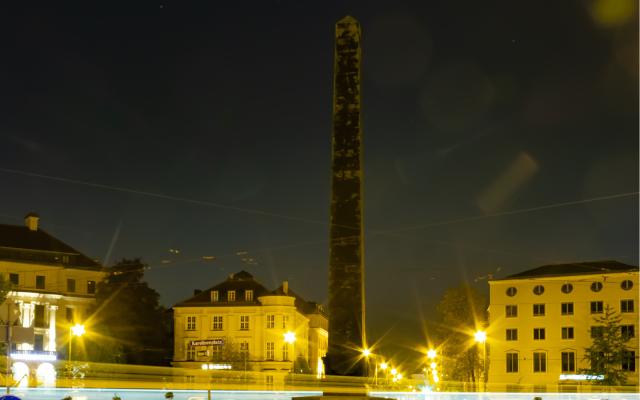The amount of time you might spend at Karolinenplatz in Munich will definitely depend on your personal interests.
If you’re a fan of French-inspired roadworks, tram watching, military history, or a spot of inner city sunbathing in summer, then you might spend an hour here at Karolinenplatz.
But if you’ve no interest in these things, then it’s likely you’ll simply take a glance at the imposing black obelisk, wonder what it is, and promptly walk on by.
Nevertheless, the history of Karolinenplatz is interesting and having spent a bit of time sitting here ourselves, we detail it all for you here.
What is Karolinenplatz?
One of Munich’s very first French-inspired garden roundabouts, Karolinenplatz is a pedestrian green space traffic roundabout that’s very popular in the warmer months with sunbathers and those office workers who need a quick break from one of the many surrounding buildings.
Aptly named after Karoline of Baden, the queen consort of Bavaria, who was born Princess Karoline Louise of Hesse-Darmstadt, Karolinenplatz can be a beautiful place in spring and summer but a somewhat open and bleak destination in the winter.
Where is Karolinenplatz?
Situated in the University district of Maxvorstadt, Karolinenplatz is situated equidistant between Konigsplatz and Odeonsplatz on Munich’s Brienner Straße.
The History of Karolinenplatz
Constructed in the early 1800s as the brainchild of architect Karl von Fischer under commission from then Crown Prince Ludwig (Later King Ludwig I), Karolinenplatz was part of the town’s urban expansion plans east of the Munich Old Town.
This was the very first square in Munich to be designed “Parisian-Style ” specifically with the intent of breaking up the orderly mundanity of the square grid street system that was in place for the new city suburb of Maxvorstadt.
Lawns and garden Beds were laid within Karolinenplatz and as further Munich city development over the years occurred, so too did the public use of the space increase.

The Black Obelisk on Karolinenplatz
The Black Obelisk on Karolinenplatz is a 29-meter-tall monument created by royal court architect Leo von Klenze. The obelisk was erected in 1835 to commemorate the 25th anniversary of King Ludwig I’s coronation, and it serves as a tribute to the soldiers who died in service to their country.
It honours the 30,000 Bavarian soldiers who died in the Russian campaign in 1812 when Bavaria had allied with France.
The obelisk was built by King Ludwig I to remember this alliance, but later became a symbol for fighting against Napoleon’s rule during the Wars of Liberation from 1813 to 1815, when Bavarian troops switched sides from fighting alongside France to fighting against it.
The Obelisk is Inscribed with the names of the Bavarian regiments that served under King Ludwig I, as well as the names of the cities and territories that made up the Kingdom of Bavaria at the time.
The obelisk also bears the inscription “LUDWIG I. KÖNIG VON BAYERN ZUM ANDENKEN AN DIE IM RUSSISCHEN KRIEGE GESTORBENEN BAYERISCHEN TRUPPEN” which translates to “Ludwig I, King of Bavaria, in memory of the Bavarian troops who died in the Russian war.”
Karolinenplatz | Not Just a Traffic Hub
Today, Karolinenplatz is a bustling commercial and transportation hub, with a mix of historic and modern buildings surrounding it.
It’s a popular thoroughfare for tourists and locals alike and is on a well-walked route.
With a number of shops, restaurants, and cultural attractions in the surrounding area you might just notice the Black Obelisk on your walk around this part of the city.
And if you do, you should stop and sit for a few minutes, check out the Obelisk, watch a tram or two negotiate the circular tracks, and be happy with your newfound knowledge of this often unnoticed Munich square.
Thanks for reading, take care and stay safe.

